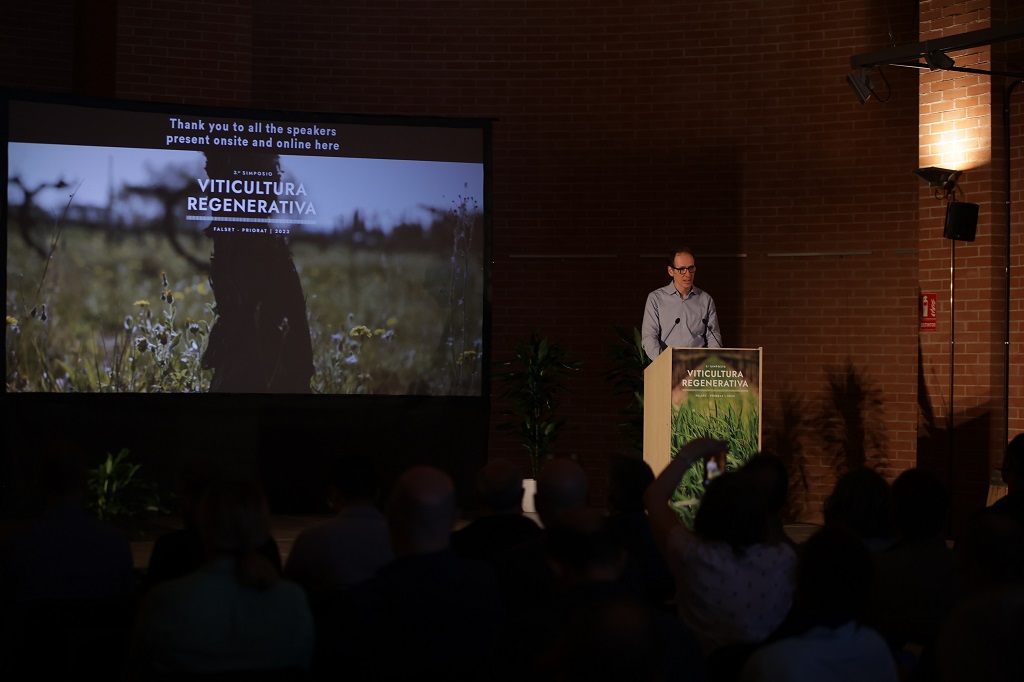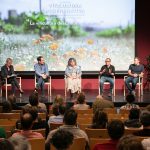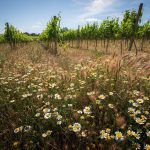Miguel Torres Maczassek, president of the Association of Regenerative Viticulture and general manager of Familia Torres, addresses the Regenerative Viticulture Symposium held recently in Spain.
On 16 May, the third edition of the Regenerative Viticulture Symposium was held in Falset, Spain. The event, which attracted around 300 attendees either in person or via streaming, was organised by the Association of Regenerative Viticulture (ARV), which created in 2021 to drive a paradigm shift in vineyard management and the adoption of regenerative viticulture — a management model based on the carbon cycle to regenerate soils, reduce erosion, encourage biodiversity and mitigate global warming.
Titled ‘Soil Microbiology: the Key to Resilient Viticulture’ and moderated by journalist Ruth Troyano, the event opened with a few thoughts from Miguel Torres Maczassek, president of the ARV Association and general manager of Familia Torres.
He emphasised “the enormous human dimension of this type of viticulture, because the greatest transformation lies not only in the soil, but in people themselves”. Torres pointed to the importance of “observing and understanding each vineyard and defining a clear roadmap towards creating ecosystems which imitate nature”.
Among the speakers were Dr Elaine Ingham, an American microbiologist and founder of Soil Food Web School. Considered one of the world’s leading soil biologists, with 40 years of experience, Ingham explained that despite initial reservations within the scientific community, she ultimately prevailed with her theory that “biology is the basis for restoring life in the soil”.
She described the dynamics that unfold in the soil food chain and the differences between fertile soil and dirt. “We must maximise the number of organisms to establish a nutrient cycle, allowing the plants to reactivate their immunity against diseases and pests”. She went on to say that “with only 3% organic matter, the biology of the soil becomes self-sufficient and can propagate; all we have to do is care for the organisms that perform all of the work in the soil.” To this end, she issued a reminder: “tilling the soil means killing beneficial microorganisms”.
The role of biology in adapting wines to global warming was addressed by Lydia and Claude Bourguignon, soil microbiologists and founders of the lab for microbiological soil analysis (LAMS). They are among the first scientists who issued a warning about soil degradation.
“Wine quality starts with a fertile soil,” they stated. They went on to say that “there are three ways of restoring the soil: adding carbon to the top layer of the soil, cover crops, compost, pruned branches; using plants with deep roots to restore soil structure and combat nematodes; and reactivating fungi and fauna, which are the finest agents of soil fertility”.
Jeff Lowenfels, author of the award-winning ‘Teaming with Microbes: the Organic Guide to the Soil Food Web’ and other books on gardening and botany, explained how the photosynthesis of plants produces exudates, nutritional substances that attract bacteria and fungi to the rhizosphere. These are then eaten by predators (nematodes, protozoa) whose remains nourish or protect the plant. Furthermore, there are mycorrhizal fungi which exchange nutrients with the roots of the plant.
“This constitutes a soil food web,” the expert stated, “and we have to let it do its work,” which meant not using chemical fertilisers. “Avoid disrupting the soil and its food web and team up with the microbes,” was among Lowenfels’ advice, who concluded by stating the obvious: “no one fertilises the forest, it grows naturally”.
Dr Rosa Vercher, an expert in pest ecology, ecological pest control and leader in sustainable pest management research, concurred that “plant health begins in the soil”. She went on to explain how the biota contributes to pest control, providing the plants with nutrients that make them more resilient. Certain parasitoids need the carbohydrates that pests supply. They are also bigger and swifter predators than their victims, and plant diversity (cover crops, wildflower strips, hedges) offers them a lot of attractive options in terms of food and shelter, thereby attracting these natural enemies of pests, which would otherwise threaten monocultures such as vineyards. For this reason, Dr Vercher encourages “plant diversity”.
For Nicole Masters, an agroecologist, director of Integrity Soils and educator in regenerative farming, regenerative viticulture “is a way of life, not a practice”. She explained how she learned to regenerate ecosystems through her experience with different kinds of plants.
In terms of vineyards, Masters commented on how stress is linked to higher quality and contemplated how the same results could be achieved, but without stressing the plant. She even considered creating an ecosystem in the vineyard to monitor grapevine health through indicators and meters (i.e. the pH of sap). She observed how good microbiology improved the flavour of the fruit. She advised winegrowers who are about to embark on this path to “travel, gather information, visit those who are already working with this model to see what they are doing, and begin applying it gradually, observing the benefits”.
Jordi Puig, PhD in Environmental Science with a specialisation in climate change and global environmental change, studied how temperature increases and water shortages affect the vineyard, resulting in a climate atlas in which he laid out two scenarios: 1971-2000 and 2000-2050. For Puig, “regenerative viticulture is an important and crucial alternative: cover crops, minimal tilling, agroforestry (helps retain nutrients and lowers soil temperature, maintains living conditions and moisture), alternating pastures, and organic matter and micronutrient applications”.
The final lecture was given by Francesc Font, vice president of the ARV and co-founder of Agroassessor, who presented the international Regenerative Viticulture Alliance (RVA) certification. An initiative of the association, in cooperation with Ecocert and the Regenerative Viticulture Foundation, the certification program will go into effect with the upcoming Northern Hemisphere harvest. The certification is designed to recognise the efforts of winegrowers and winemakers who have embraced the regenerative viticulture model to ensure the future of viticulture.
A video of the conference is available here.
Are you a Daily Wine News subscriber? If not, click here to join our mailing list. It’s free!





















